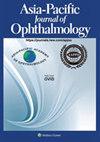人工智能在糖尿病黄斑水肿精准医学中的应用。
IF 3.7
3区 医学
Q1 OPHTHALMOLOGY
引用次数: 0
摘要
糖尿病黄斑水肿(DME)是糖尿病患者中心视力受损的主要原因,也是工作年龄人群可预防失明的主要原因。随着光学相干断层扫描和抗血管内皮生长因子(anti-VEGF)治疗的出现,DME的诊断、评估和治疗在过去十年中发生了巨大的变革。然而,DME患者之间存在巨大的异质性,30%-50%的DME患者对抗VEGF药物反应不佳。此外,还没有循证且普遍接受的给药方案。DME的两个主要挑战是识别对抗VEGF药物没有反应的DME患者和确定最佳给药间隔,这在传统医疗模式的粗粒度下很难实现。因此,近年来越来越多的视网膜专家指出了将精准医学引入DME管理的必要性,并进行了相关研究。最前沿的方法之一是基于人工智能技术从光学相干断层扫描图像中有针对性地提取个性化疾病特征,为DME提供精确的评估和风险分类。这篇综述旨在概述人工智能精准医学在DME的自动筛查、精确评估、预后预测和随访监测方面的进展。此外,还将讨论DME在实际应用中面临的挑战以及精确医学的未来发展。本文章由计算机程序翻译,如有差异,请以英文原文为准。
Application of Artificial Intelligence in Precision Medicine for Diabetic Macular Edema
Diabetic macular edema (DME) is the primary cause of central vision impairment in patients with diabetes and the leading cause of preventable blindness in working-age people. With the advent of optical coherence tomography and antivascular endothelial growth factor (anti-VEGF) therapy, the diagnosis, evaluation, and treatment of DME were greatly revolutionized in the last decade. However, there is tremendous heterogeneity among DME patients, and 30%–50% of DME patients do not respond well to anti-VEGF agents. In addition, there is no evidence-based and universally accepted administration regimen. The identification of DME patients not responding to anti-VEGF agents and the determination of the optimal administration interval are the 2 major challenges of DME, which are difficult to achieve with the coarse granularity of conventional health care modality. Therefore, more and more retina specialists have pointed out the necessity of introducing precision medicine into the management of DME and have conducted related studies in recent years. One of the most frontier methods is the targeted extraction of individualized disease features from optical coherence tomography images based on artificial intelligence technology, which provides precise evaluation and risk classification of DME. This review aims to provide an overview of the progress of artificial intelligence-enabled precision medicine in automated screening, precise evaluation, prognosis prediction, and follow-up monitoring of DME. Further, the challenges ahead of real-world applications and the future development of precision medicine in DME will be discussed.
求助全文
通过发布文献求助,成功后即可免费获取论文全文。
去求助
来源期刊

Asia-Pacific Journal of Ophthalmology
OPHTHALMOLOGY-
CiteScore
8.10
自引率
18.20%
发文量
197
审稿时长
6 weeks
期刊介绍:
The Asia-Pacific Journal of Ophthalmology, a bimonthly, peer-reviewed online scientific publication, is an official publication of the Asia-Pacific Academy of Ophthalmology (APAO), a supranational organization which is committed to research, training, learning, publication and knowledge and skill transfers in ophthalmology and visual sciences. The Asia-Pacific Journal of Ophthalmology welcomes review articles on currently hot topics, original, previously unpublished manuscripts describing clinical investigations, clinical observations and clinically relevant laboratory investigations, as well as .perspectives containing personal viewpoints on topics with broad interests. Editorials are published by invitation only. Case reports are generally not considered. The Asia-Pacific Journal of Ophthalmology covers 16 subspecialties and is freely circulated among individual members of the APAO’s member societies, which amounts to a potential readership of over 50,000.
 求助内容:
求助内容: 应助结果提醒方式:
应助结果提醒方式:


